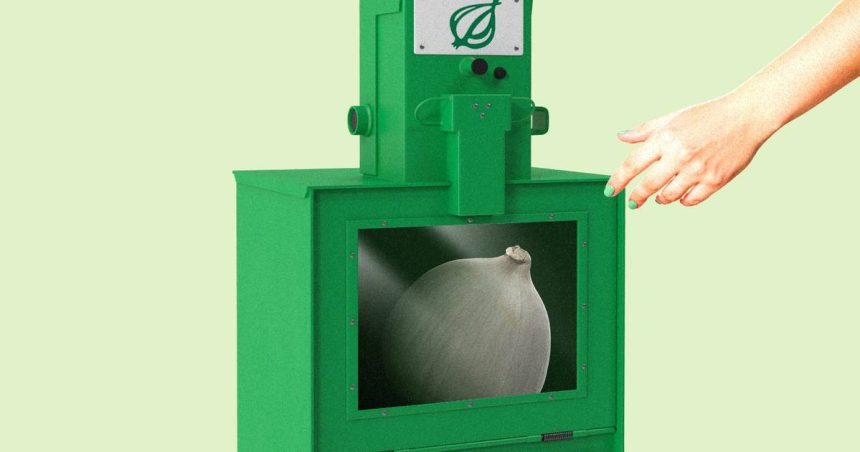America’s finest news source hasn’t been a print news source since the “Harlem Shake” was trending.
Over the last 11 years, the state of print media hasn’t exactly gotten stronger. But as of last month, the satirical publication The Onion, which G/O Media sold to a group of media executives and journalists earlier this year, began circulating hard copies once again.
Ben Collins, CEO of The Onion’s parent company, Global Tetrahedron, told the New York Times that the hope is for the paper to begin turning a profit later this year. To help achieve that, CMO Leila Brillson told Marketing Brew that the plan is to lean heavily into memberships, which begin at $99/year for print subscriptions. Those who pay less can still gain access to “member-exclusive emails and other periodic benefits,” some of which Brillson said the publication is still deciding on.
“Print is a huge part of it, and it’s the primary product, but we want to be able to also do really fun, cool things with the archive, the digital edition, bizarre things you’ll find in your inbox, weird mailers, just really Onion stuff,” Brillson said.
Since the membership became available last month, Brilson said her team’s expectations around sign-ups “have been blown out of the water,” although she declined to share specific numbers. We spoke with her about what readers and advertisers can expect next—and whether a print newspaper can make it in 2024.
A layered history
Returning to print despite a tough media market was driven in part by fan fervor and the desire to lean into The Onion’s historical legacy, Brillson said. At the same time, The Onion has invested in social, and Brillson said the publication is seeing promising engagement on its TikTok content, particularly among Gen Z.
“I think of it as a real moving-forward-while-looking-back moment,” she said, adding that The Onion’s TikTok is “not any less of a priority for us than the printed paper.”
So far, she said, there have been some indications that social engagement has helped drive membership growth. The publication has been advertising on TikTok to promote its return to print, in addition to posting organic content, she said.
Brillson, who previously worked at TikTok, as well as at brands like Bumble and Netflix, said she’s learned from her experience the power of identity-based products. Like how vinyl records became popular again in the last decade, newspapers and magazines can also act as personal identifiers, she said.
Get marketing news you’ll actually want to read
Marketing Brew informs marketing pros of the latest on brand strategy, social media, and ad tech via our weekday newsletter, virtual events, marketing conferences, and digital guides.
But in the same way that few listeners exclusively listen to vinyl, she doesn’t expect anyone to only read print.
“I don’t necessarily think print is the future,” Brillson said. “I think that a really well-curated object that people want is the future. Meeting people where they are is also the future. These two things are not mutually exclusive.”
Peeling back
Brillson acknowledged that it can be challenging to build out monetization strategies beyond memberships. Since leaving G/O Media, the site has ended its business with the content recommendation company Taboola, but it continues to run Google Ads, execs told The Verge last month. In print, Brillson said the team is exploring everything from full-page to backpage ads—ideally funny ones, she said—and has also floated the idea of hosting events.
While her team has received “a lot of inbounds” to date, she said, they’ve been “really picky” about the advertisers entertained. “The majority of our advertisers are mission-driven, but we’re looking for anybody who really aligns with The Onion,” she said. “We’re never going to be a straightforward ad partner, so if you’re interested in display media and display media only, there’s probably bigger and better and more efficient places you can go.”
There are some digital media strategies that Brillson does not want to explore. For instance, The Onion will “never be paywalled as long as I’m here,” she said, because the publication has historically been free, which allows it to spread far on social media.
“I’ve been doing this for a long time, and I have never seen [social] shares to this level,” she said. “We don’t want to discourage that.”
There are plenty of questions about whether a print newspaper can be revived in 2024, but Brillson said she’s encouraged by one major change in the last decade.
“Ten years ago, impressions-based advertising ruled the world,” she said. “The Onion is not going to win with impressions-based advertising, and print is not going to win with impressions-based advertising because its CPM is way too high…But now with the niche being mainstream and mainstream not really existing, we found that we have a real opportunity to more meaningfully connect brands with our audience.”
Read the full article here










